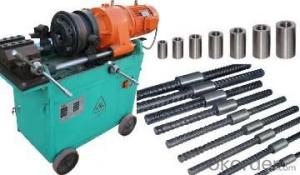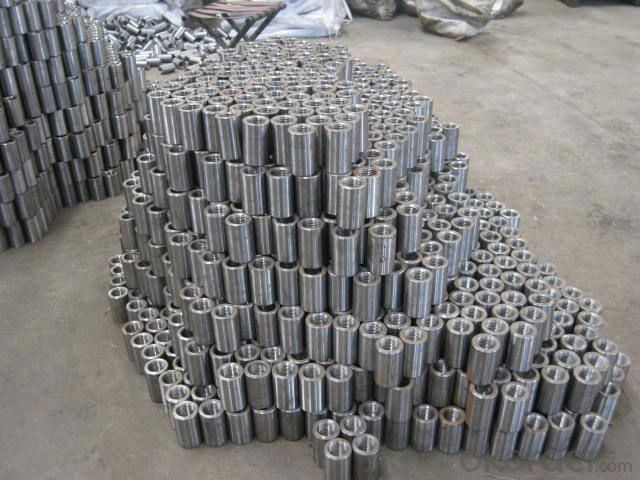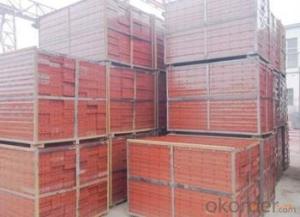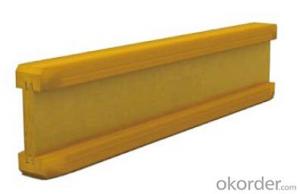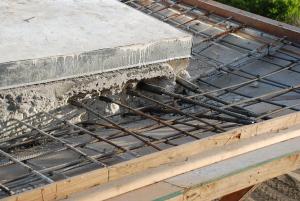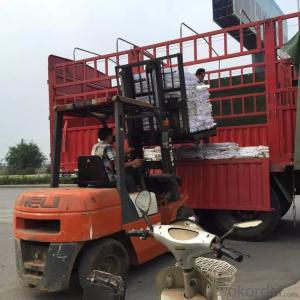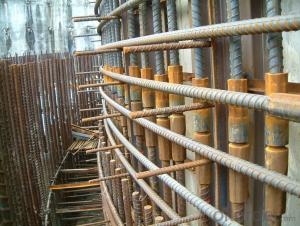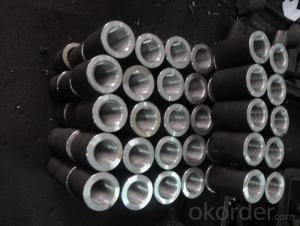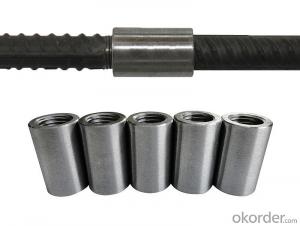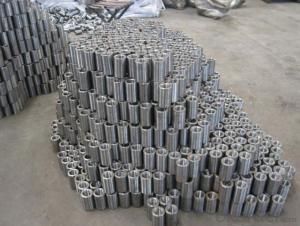Steel Coupler Rebar China Scaffolding Scaffolding Machine CNBM
- Loading Port:
- Shanghai
- Payment Terms:
- TT OR LC
- Min Order Qty:
- 50 pc
- Supply Capability:
- 10000000 pc/month
OKorder Service Pledge
OKorder Financial Service
You Might Also Like
Steel Coupler Rebar China Scaffolding Scaffolding Machine CNBM
1.Description:
Lapped joints are not always an appropriate means of connecting rebar. The use of Steel Rebar Couplers can simplify the design and construction of reinforced concrete and reduce the amount of reinforcement required.
The threaded steel coupler system is designed as a threaded reinforcement connection with 100% load transmission. The steel coupler rebar connection system is suitable for both static and dynamic load transmission in construction joints.
The coupler is designed as a threaded reinforcement connection for formed construction joints. Reinforcement work is normally carried out on both sides of the construction joint using lap joints or one side is anchored. The bar lengths are based on the structural analysis requirements of the building component and are calculated from anchorage and lap lengths.

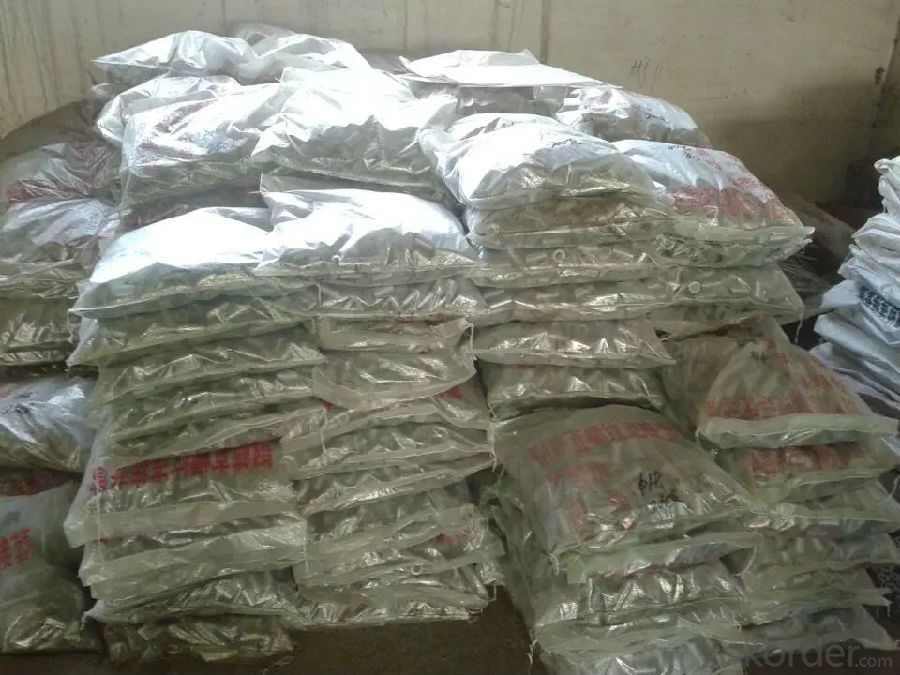
2.Advantages of Steel Coupler Rebar Lift Scaffolding Galvanized Scaffolding Tube with Low Price:
The coupler system provides the opportunity to connect rebars quickly, easily and cost effectively, even when large rebar diameters are used. This makes the steel coupler rebar range a logical extension to our rebendable CNBM reinforcement continuity system for rebars over 12 mm.
3.Available sizes of Steel Coupler Rebar Lift Scaffolding Galvanized Scaffolding Tube with Low Price:
14mm,16mm,18mm,20mm,22mmm,25mm,28mm,32mm,36mm,40mm
4.Delivery:
Delivery Term: FOB / CFR / CIF available.
Delivery Time: 15 days or less after order confirmed.
5.Why choose us?
Technical Expertise
Experienced Management
Stringent Quality Control
Exemplary Service
On-Time Delivery
Wide Product Range
Competitive Pricing
Huge branch network capable of catering worldwide
- Q: Can steel formwork be used for projects with stringent quality requirements?
- Yes, steel formwork can definitely be used for projects with stringent quality requirements. Steel formwork is known for its durability, strength, and consistency, making it an ideal choice for projects where precision, accuracy, and high-quality finishes are essential. Steel formwork is capable of withstanding heavy loads and can maintain its shape and dimensions over multiple uses, ensuring that the concrete structure is formed accurately and precisely according to the design specifications. Additionally, steel formwork provides a smooth surface finish, reducing the need for extensive post-construction finishing work. Its robustness and stability make it suitable for projects requiring stringent quality control, such as high-rise buildings, bridges, and infrastructure projects. Furthermore, steel formwork allows for easy customization, enabling contractors to meet specific project requirements efficiently. Overall, steel formwork is a reliable and efficient choice for projects with stringent quality requirements, ensuring that the final structure meets the highest standards of quality and durability.
- Q: How is steel formwork installed?
- Steel formwork is installed in a systematic and efficient manner to ensure accurate and sturdy construction. The process typically involves the following steps: 1. Planning and preparation: Before installing steel formwork, careful planning and preparation are essential. This includes determining the desired shape and dimensions of the concrete structure, calculating the required amount of steel formwork panels and accessories, and ensuring all necessary tools and equipment are available. 2. Site preparation: The construction site needs to be prepared adequately. This involves clearing the area of any debris or obstacles, leveling the ground, and ensuring a solid foundation. 3. Positioning and alignment: Steel formwork panels are positioned and aligned according to the planned structure. This is done by connecting and securing the panels using various methods, such as clamps, nuts, bolts, or pins. It is crucial to ensure proper alignment and tightness to prevent any leakage or seepage of concrete. 4. Reinforcement installation: If required, steel reinforcement bars are installed within the formwork to provide additional strength and support to the concrete structure. These reinforcement bars are precisely placed according to the structural design and secured firmly to the formwork panels. 5. Formwork bracing: To ensure stability and prevent any deformation during the pouring and curing of concrete, steel formwork needs to be adequately braced. Bracing helps distribute the load evenly and maintain the desired shape of the structure. Horizontal and vertical bracing systems are used to provide the necessary support and rigidity. 6. Pouring and compacting concrete: Once the steel formwork is securely in place and braced, concrete is poured into the formwork. The concrete is then compacted using vibrators or other suitable equipment to remove any air bubbles and ensure proper adhesion and density. 7. Curing and removal: After the concrete is poured and compacted, it needs to be cured to achieve maximum strength and durability. Curing can be done by various methods, such as covering the structure with plastic sheets or water spraying. Once the concrete has sufficiently cured, the steel formwork can be removed carefully, starting from the top and gradually moving downwards. It is important to note that the installation process may vary depending on the specific project requirements, complexity of the structure, and the type of steel formwork used. Therefore, it is always advisable to consult with experienced professionals or engineers to ensure proper installation and adherence to safety standards.
- Q: What are the common types of connections used in steel formwork systems?
- Steel formwork systems utilize various types of connections, including wedge connections, pin and wedge connections, bolted connections, clamped connections, and magnetic connections. Wedge connections involve employing a wedge-shaped device to firmly secure the panels together. The wedge is inserted into a slot and tightened, creating a dependable and robust connection. Pin and wedge connections entail using pins and wedges to connect the formwork panels. The pins are inserted through panel holes, and the wedges are then driven into the pins, effectively locking them in position. Bolted connections utilize bolts to connect the formwork panels. Pre-drilled holes are present in the panels, and bolts are inserted through these holes and tightened with nuts. This connection method allows for effortless disassembly and reassembly of the formwork system. Clamped connections employ clamps made of steel to connect the formwork panels. These clamps are tightened using bolts or screws, resulting in a secure and rigid joint between the panels. Magnetic connections rely on magnets to connect the formwork panels. Magnetic strips or plates are embedded in the panels, and when the panels are brought close together, the magnets attract and hold them in place. While this connection method is quick and easy, it may not possess the same strength as other connection methods. Each of these connection types offers distinct advantages and disadvantages. The selection of a connection method depends on various factors, including project requirements, ease of assembly and disassembly, as well as the desired strength and stability of the formwork system.
- Q: Are there any specific considerations for using steel formwork in earthquake-prone areas?
- Yes, there are specific considerations for using steel formwork in earthquake-prone areas. Steel formwork is known for its strength and durability, which is why it is often preferred in seismic regions. However, there are several factors that need to be taken into account when using steel formwork in earthquake-prone areas: 1. Flexibility: Steel formwork should be designed to have the necessary flexibility to withstand seismic forces. It should be able to absorb and dissipate the energy generated during an earthquake, reducing the risk of structural damage. 2. Connection details: The connection details between the steel formwork components should be carefully designed and engineered to ensure proper load transfer and resistance to seismic forces. Special attention should be given to the joints and connections to prevent failure or collapse during an earthquake. 3. Reinforcement: Additional reinforcement might be required to enhance the strength and stiffness of the steel formwork system. This reinforcement can be in the form of additional steel bars, cross bracing, or diagonal struts to provide increased resistance against lateral forces. 4. Anchorage: Proper anchorage of the steel formwork to the supporting structure is crucial in earthquake-prone areas. The formwork should be securely anchored to the foundation or the structural elements to prevent displacement or movement during an earthquake. 5. Inspection and maintenance: Regular inspection and maintenance of the steel formwork system are essential in earthquake-prone areas. Any damage or wear should be identified and repaired promptly to ensure the integrity and stability of the formwork system. 6. Compliance with building codes: It is important to ensure that the steel formwork system complies with the local building codes and regulations for seismic design. These codes provide guidelines and requirements for the design, installation, and use of formwork in earthquake-prone areas. By considering these specific factors, using steel formwork in earthquake-prone areas can provide enhanced structural resilience and contribute to the overall safety and durability of the construction project.
- Q: What is the steel formwork and its construction advantages
- Steel formwork is an energy-saving and environment-friendly products, after the wooden template, composite steel formwork, bamboo plywood, all steel template and a new type of product. Can completely replace the steel formwork, formwork, timber, traditional energy saving and environmental protection, low cost amortization.
- Q: What are the considerations when designing steel formwork for industrial facilities?
- When designing steel formwork for industrial facilities, there are several important considerations that need to be taken into account. These considerations include: 1. Load-bearing capacity: Industrial facilities often house heavy machinery and equipment, so the steel formwork needs to be designed to withstand the weight and load placed on it. The formwork should be able to support the weight of the machinery while ensuring structural stability and safety. 2. Durability: Steel formwork should be able to withstand the harsh conditions often found in industrial facilities, such as temperature fluctuations, exposure to chemicals or corrosive substances, and heavy usage. It should be designed to have a long lifespan and require minimal maintenance to ensure cost-effectiveness. 3. Flexibility and adaptability: Industrial facilities often undergo changes, upgrades, or modifications over time. Therefore, the steel formwork should be designed to be flexible and adaptable, allowing for easy modifications or additions as required. This includes considering factors such as future expansion, reconfiguration, or relocation of machinery or equipment. 4. Safety: Safety is a crucial consideration when designing steel formwork for industrial facilities. The formwork should be designed to prevent accidents or injuries, such as by incorporating safety features like guardrails, non-slip surfaces, or adequate lighting. It should also adhere to relevant safety codes and standards to ensure compliance. 5. Ease of construction and dismantling: Steel formwork should be designed to be easily assembled and disassembled. This will not only save time during construction but also allow for efficient reusability of the formwork in future projects. Considerations like modular designs or prefabricated components can facilitate easier construction and dismantling processes. 6. Cost-effectiveness: Designing steel formwork for industrial facilities should also take into account cost-effectiveness. This includes optimizing material usage, minimizing waste, and considering the long-term maintenance and operational costs. Balancing the initial investment with the expected lifespan and benefits of the formwork is essential to achieve the most cost-effective solution. Overall, designing steel formwork for industrial facilities requires careful consideration of load-bearing capacity, durability, flexibility, safety, ease of construction, and cost-effectiveness. By addressing these considerations, designers can ensure that the formwork meets the specific requirements of industrial applications and provides a reliable and efficient solution for construction projects.
- Q: What are the considerations when designing steel formwork for underground utilities?
- There are several essential factors to consider when designing steel formwork for underground utilities. These considerations encompass: 1. Structural Integrity: It is necessary to ensure that the formwork can withstand the pressure and forces exerted by the surrounding soil and any potential external loads. The design should offer sufficient strength and stability throughout the construction process. 2. Water and Chemical Resistance: Underground utilities are often exposed to water and various chemicals. Consequently, the formwork must be designed to resist corrosion and deterioration caused by these elements, ensuring its durability. 3. Accessibility for Installation and Maintenance: The formwork design should facilitate easy access during installation and future maintenance activities. This may involve incorporating provisions for openings, removable sections, or access points to allow workers to easily reach the utilities when necessary. 4. Modular Design: Utilizing a modular design can provide flexibility and simplify installation. Modular formwork systems enable quick assembly and disassembly, which proves advantageous when dealing with different underground utility layouts and configurations. 5. Safety: Safety is of utmost importance in any construction project. Therefore, the formwork design should include safety features such as guardrails, handrails, and anti-slip surfaces to minimize the risk of accidents and injuries during construction and maintenance. 6. Cost-effectiveness: The design should strike a balance between performance and cost. It should be optimized to minimize material usage and labor costs while maintaining quality and durability. 7. Compatibility with other construction methods: The design should be compatible with other construction methods and materials used for the underground utilities. This encompasses considerations for joining techniques, such as welding or bolting, and compatibility with other materials, such as concrete or PVC pipes. By taking these factors into account, designers can ensure that the steel formwork for underground utilities is structurally sound, resistant to environmental factors, easily accessible for installation and maintenance, safe for workers, cost-effective, and compatible with other construction methods.
- Q: How does steel formwork handle different concrete surface sealing products?
- Steel formwork is a commonly used material in the construction industry for creating molds or structures to pour concrete into. When it comes to handling different concrete surface sealing products, steel formwork has certain advantages and considerations. Firstly, steel formwork is highly durable and robust, which makes it well-suited to withstand the application of different concrete surface sealing products. These sealing products, such as epoxy coatings, polyurethane sealers, or acrylic sealants, are typically designed to enhance the durability, aesthetics, and resistance of the concrete surface. Steel formwork can handle the application process without getting damaged or compromised. Secondly, steel formwork provides a smooth and even surface for the application of concrete surface sealing products. This is crucial as a proper seal requires an even and consistent application to ensure optimal performance. Steel formwork, when properly constructed and maintained, can provide the necessary level of precision and flatness needed for the successful application of sealing products. However, it is important to note that steel formwork may require additional preparation and precautions when using certain concrete surface sealing products. For example, if a sealing product requires a clean and porous surface for proper adhesion, the steel formwork may need to be treated or roughened to create the desired surface texture. This can be achieved through techniques such as sandblasting or applying a bonding agent. Furthermore, steel formwork should be properly cleaned and free from any residues or contaminants before applying concrete surface sealing products. Any residual concrete, oils, or dirt on the formwork may interfere with the adhesion and performance of the sealing products. Regular maintenance and cleaning of the steel formwork are essential to ensure its compatibility with different concrete surface sealing products. In conclusion, steel formwork is a reliable and sturdy material that can handle different concrete surface sealing products. Its durability, precision, and smooth surface make it a suitable choice for the application of various sealing products. However, additional preparation, maintenance, and cleaning may be required to ensure optimal compatibility and performance.
- Q: Can steel formwork be used for both vertical and inclined concrete placements?
- Yes, steel formwork can be used for both vertical and inclined concrete placements. Steel formwork is known for its high strength and durability, making it suitable for various construction applications. Whether it is a vertical wall or an inclined surface, steel formwork can provide the necessary support and shape to hold the concrete in place until it sets and hardens. Steel formwork offers flexibility in terms of shape and design, allowing it to be easily adjusted and adapted for inclined placements. The formwork panels can be connected and fixed at different angles to create the desired inclination. This flexibility enables contractors to construct structures with various slopes, such as ramps, stairs, and inclined walls. Furthermore, steel formwork can withstand the pressure exerted by the fresh concrete during the pouring and curing process. It provides a stable and secure framework that prevents the concrete from collapsing or deforming. This is particularly important when dealing with inclined placements, as the concrete tends to exert more lateral pressure on the formwork. Additionally, steel formwork offers the advantage of being reusable. Unlike traditional timber formwork, steel formwork can be easily dismantled and reassembled for future projects. This not only reduces construction costs but also minimizes waste and environmental impact. In conclusion, steel formwork is a versatile solution that can be used for both vertical and inclined concrete placements. Its strength, durability, and adaptability make it an ideal choice for various construction projects.
- Q: Can steel formwork be used for concrete culverts?
- Yes, steel formwork can be used for concrete culverts. Steel formwork is a strong and durable material that can withstand the pressure and weight of the concrete being poured into it. It provides a stable framework for shaping and supporting the concrete until it sets and hardens. Additionally, steel formwork can be easily assembled and disassembled, allowing for reuse and cost-effectiveness. It is commonly used in construction projects, including the construction of concrete culverts, due to its strength, versatility, and long lifespan.
Send your message to us
Steel Coupler Rebar China Scaffolding Scaffolding Machine CNBM
- Loading Port:
- Shanghai
- Payment Terms:
- TT OR LC
- Min Order Qty:
- 50 pc
- Supply Capability:
- 10000000 pc/month
OKorder Service Pledge
OKorder Financial Service
Similar products
Hot products
Hot Searches
